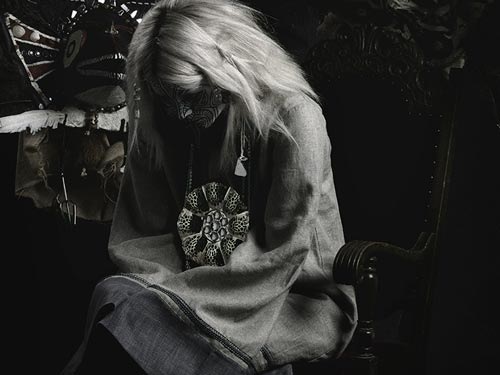If you pay attention to music writing, you’ll know these last few
weeks have felt like a post-mortem, and one held prematurely: the
decade laid out on a slab, filleted, and examined before it’s even breathed its last. Of course, it’s understandable to want to ask the questions, which roughly boil down to: where are we? But I dunno, maybe this is me admitting failure on behalf of my trade or something, but the whole process, this constant pulse-checking, feels spiritually exhausting. And more than that, it seems to miss the real truth – that the most special things, the things that captivate and haunt us are often the things that remain unexplained, unfathomable.
Green lasers cut through the darkness, hard and green, like lightning harnessed. Bodies move in the darkness, illuminated by glowing lamplight – men with the faces of birds, a figure clad in flowing red like a masked Red Death. And there, shifting and bobbing in the gloom, is a mossy monolith that conceals one Karin Elisabeth Dreijer Andersson. “If “I had a heart I could love you,” she moans, her voice pitched down to a zombie groan. “If I had a voice I would sing…”
Andersson, one half of Swedish electro-pop duo The Knife, debuted the Fever Ray name late 2008 with the single ‘If I Had A Heart’. Barely 12 months later, and Fever Ray have outstripped The Knife in terms of popularity, in the UK at least. For many, a gig such as tonight’s would be a point of career consolidation. Instead, tonight Andersson is here to put Fever Ray to death.
In interviews, Andersson has suggested that Fever Ray’s sole,
self-titled album is about motherhood – the sleepless nights, the
constant creeping tiredness, the naive fantasies of a brain not yet fully-formed. Listen to it, mind, and little of this is explicit. Instead, Fever Ray was assembled from a strange, unsettling bricolage of influences: Norwegian black metal and Scandinavian folk tales, the misty orientalism of Japan’s ‘Ghosts’ and the eerie slowness of chopped-and-screwed rap, the films of David Lynch and Jim Jarmusch – even, as Andersson suggested in interviews, the stylised slowness of Miami Vice, with its glacial electronic soundtrack and long, graceful pans. Her lyrics, when you can decipher them are gnomic, but uncertain, dwelling in non-sequiters. “I live between concrete walls/When I took her up she was so warm,” she sings on ‘Concrete Walls’. “Memory comes when memory’s old/I am never the first to know/Following the stream up North/Where do people like us float?" she questions on ‘Keep The Streets Empty For Me’.
Watching this play out onstage is both unsettling and fascinating. Like a glimpse of strange rites inside some hidden grove, Fever Ray – much like Sunn0))), with their druidic, ritualised take on heavy metal – imagine a place where ancient magick and modern technology meet. Some of the musicians add percussion with strange long sticks covered with bells, like nightmarish Morris dancers. A man in a bird mask waves what appears to be a corn dolly on a long pole over the heads of
the crowd. But there is also evidence here of a very crisp,
technologic precision. Lasers cut through the air above and then
slowly spread, like Japanese fans. At certain points, the lasers shift to encage the stage, crossing at acute angles – mimicking, perhaps, the sense of special confinement and sensual disorientation in the music. On ‘Seven’, Andersson removes her hood to reveal long blonde hair and a face painted with a triangle that mimics the geometric formations traced out above.
There’s been a lot of critical griping about cultural stagnation
recently – how hip-hop has gone stale, how indie-rock is hopelessly in thrall to a ‘Don’t Look Back’ vision of its past, and so on and so on. What’s behind that, I think, is the idea that music should be ‘progressive’ – that like the shark, it’s either moving forward, or it’s dead. It’s a seductive way of thinking, but for me it doesn’t quite ring true. Music culture isn’t really a continuum – it’s a collision of discrete factors: social, environmental, technologic, narcotic. Fever Ray, though, suggests that invoking the past is not necessarily something to be afraid of. I spoke to Andersson earlier this year, and one thing that stuck in my mind was her emphasis on what she referred to as the music’s ‘folk’ elements – not in the sense of beards and acoustic guitars, but the influence of traditional or non-Western musics: African pop, traditional Chinese music, Romanian gypsy music. Of course, in Fever Ray it is treated with irreverence, sounds are cut free from their cultural moorings and left to drift like a dream. But it’s this process of decontextualisation, this stitching together of disparate cultural scraps, that gives the likes of ‘Triangle Walks’ and ‘When I Grow Up’ their strange, otherworldly quality. Fever Ray’s innovation is not of any contrived futurism, but of new vantage points, fresh ways of seeing – be it illuminated by lasers, or through the eyes of a child.
It’s ‘When I Grow Up’, arriving at the set’s end, that’s the closest tonight comes to a moment of communion. A tale of young ambition, of seasides and crab’s claws, deep forests and tended gardens, it’s a song that a crowd can sing back – and they do. Even so, though, something at its core remains opaque and unknowable. Fever Ray’s music dwells in realms of confusion and illusion. But it grabs our hand and
pulls us in too, sublime and perfect.



